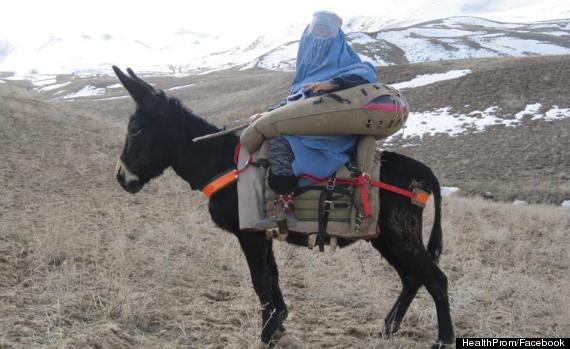Afghanistan has the worst rate of maternal mortality[1] in the world, a devastating fact that could potentially be reversed with the recently developed donkey ambulance.
One in 11 women in Afghanistan die of causes related to pregnancy and birth[2] during her childbearing years, according to WHO, mainly due to issues related to poverty, cultural barriers and inaccessibility to proper medical care.
To at least eliminate one problem -- the fact that many pregnant women don’t have access to transportation that could take them over the rocky Afghanistan terrain to medical centers when they’re giving birth – HealthProm, a British charity that’s working to reduce child and maternal mortality and designer Peter Muckle invented the donkey ambulance[3] , so that they can travel safely to a hygienic center.

Photo: HealthProm/Facebook [4]
Since there is an abundance of donkeys in Afghanistan, and they’re able to handle traveling through the area’s mountainous terrain, Muckle figured attaching a secure saddle to the animal could safely, and inexpensively, get a woman in labor to the hospital.
The saddle, where the woman sits, is composed of inflatable camping cushions and the U-shaped support is made of a pool lounger. [5] The entire contraption costs about $100 to make.
Muckle told the BBC that he’s gotten a “positive” response from women who have used it and hopes local developers will recreate the product once it takes off.
"It's a pattern that I've made, so it's something that we are not selling really as a saddle -- we're giving the pattern to people to copy," Muckle told the Atlantic. [6] "So the idea is to make it a simple pattern that works very well [and] that people can make themselves."
Feeling inspired? Find out how you can support HealthProm's mission to bring donkey ambulances to Afghanistan here. [7]
Also on HuffPost:
References
- ^ Afghanistan has the worst rate of maternal mortality (www.reuters.com)
- ^ One in 11 women in Afghanistan die of causes related to pregnancy and birth (www.reuters.com)
- ^ donkey ambulance (vimeo.com)
- ^ Photo: HealthProm/Facebook (www.facebook.com)
- ^ the U-shaped support is made of a pool lounger. (www.bbc.co.uk)
- ^ Muckle told the Atlantic. (www.theatlantic.com)
- ^ here. (us2.campaign-archive2.com)
- ^ Send us a tip (www.huffingtonpost.com)
- ^ Send us a photo or video (www.huffingtonpost.com)
- ^ Suggest a correction (www.huffingtonpost.com)

0 comments:
Post a Comment